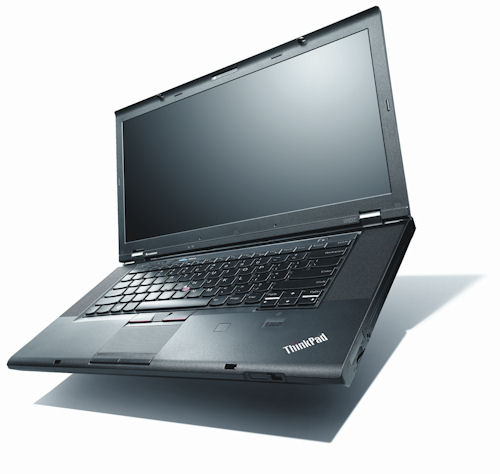Mobile Champion
The new Lenovo ThinkPad W530 mobile workstation delivers incredible price and performance.
December 4, 2001
Over the past few years, we’ve reviewed numerous Lenovo ThinkStation workstations. We’ve consistently been impressed with the company’s ability to deliver performance at an affordable price. But it’s been more than four years since we last looked at one of the company’s mobile workstations. We were, therefore, excited when the Lenovo ThinkPad W530 arrived.
 The new Lenovo ThinkPad W530 mobile workstation is an elegant, portable and capable performer. |
The 15.6-in. ThinkPad W530 represents a significant change from last Lenovo mobile workstation we reviewed (DE, January 2009). While that ThinkPad W700 was impressive, at more than 9 lbs., plus its large power supply, it was big and bulky—and also cost more than $3,500. The new ThinkPad W530 is svelte in comparison, measuring 9.65x14.68x1.40 in., and tipping the scales at just 6.3 lbs. (plus 1.3 lbs. for its 170-watt power supply). The matte black carbon fiber case has a nice sculpted form, with the nine-cell lithium-ion battery adding an extra inch to the total depth of the system.
Lenovo offers the W530 with a choice of third-generation processors. Our evaluation unit came equipped with a top-of-the-line Intel Core i7-3920XM quad-core 2.90GHz mobile extreme CPU. This 32nm “Ivy Bridge processor has a maximum turbo speed of 3.8GHz, includes 8MB of SmartCache, supports PCIe 3.0, and has a thermal design power (TDP) rating of 55 watts.
Although the CPU included integrated Intel HD Graphics 4000, the W530 comes standard with either an NVIDIA Quadro K1000M or the K2000M professional mobile workstation graphics board we received. Both are based on NVIDIA’s latest Optimus technology for optimized graphics performance and long battery life and include 2GB of DDR3 graphics memory. The more powerful K2000M features 384 compute unified device architecture (CUDA) cores and a 28.8GB/second memory bandwidth. Our evaluation unit also came equipped with 16GB of DDR3 system memory, installed as four 4GB 1,600MHz dual in-line memory modules (DIMMs), although the ThinkPad W530 can support a total of 32GM of memory using 8GB DIMMs.
Impressively Equipped
A single slide latch near the right-front edge of the case releases the lid to reveal a full HD 1920x1080-pixel LED backlit antiglare display and an 84-key keyboard flanked on either side by speakers. The keyboard is perhaps the nicest we’ve ever seen in a mobile workstation, with key spacing comparable to a desktop keyboard and well-shaped keys. Our only complaint was the lack of a separate numeric keypad.
A red TrackPoint pointing stick is nestled above the B key, with three dedicated buttons located below the spacebar. Centered below this is a touch pad with its own pair of buttons. In addition to standard one-finger movements and a dedicated scroll zone along the right edge, the touch pad also supports gestures such as a two-finger spread or pinch to zoom in and out within documents, and a two-finger vertical swipe to scroll.
To the right of the touch pad, the optional color sensor included in our system works in conjunction with the supplied X-Rite software to measure and adjust the accuracy of the display. An optional fingerprint reader, located to the right of the sensor, enables you to enroll your fingerprint to control access to the system.
A round power button is located to the upper right of the keyboard, while four buttons to the upper left mute the speakers, adjust volume, and mute the microphone. A fifth button activates a special Lenovo SimpleTap app, which lets you access the computer’s settings and launch frequently used applications and websites. This button also accesses the Rescue and Recovery workspace, for rescuing files or restoring the drive to its factory default settings.
Expansion options are very well organized. The right side of the case provides a security lock, RJ-45 network jack, a Serial Ultrabay (which in our evaluation unit contained a DVD read/write drive), a combo audio jack (for headphones or external speakers), a media card reader slot, and an ExpressCard slot. The left side houses a mini DisplayPort connector, VGA port, two USB 3.0 ports, a USB 2.0 port, a mini 1394a FireWire port, a switch for the wireless LAN/Bluetooth radio, and a SmartCard slot.
Portable Workstations Compared
| Lenovo W530 mobile workstation (2.90GHz Intel Core i7-3920XM quad-core CPU, NVIDIA Quadro K2000M, 16GB RAM) | Eurocom P150HM Racer mobile workstation (2.70GHz Intel Core i7-2960XM quad-core CPU, NVIDIA Quadro 5010M, 16GB RAM) | HP EliteBook 8560w mobile workstation (2.30GHz Intel Core i7-2820QM quad-core CPU, NVIDIA Quadro 2000M, 16GB RAM) | ||
| Price as tested | $2,592 | $4,933 | $4,063 | |
| Date tested | 12/29/12 | 5/1/12 | 5/1/12 | |
| Operating System | Windows 7 | Windows 7 | Windows 7 | |
| SPECview 11 | higher | |||
| catia-03 | 34.82 | 49.74 | 27.49 | |
| ensight-04 | 18.40 | 41.07 | 18.46 | |
| lightwave-01 | 62.75 | 60.13 | 48.21 | |
| maya-03 | 62.04 | 93.79 | 58.12 | |
| proe-5 | 15.58 | 10.97 | 9.77 | |
| sw-02 | 39.48 | 53.57 | 35.85 | |
| tcvis-02 | 30.63 | 45.65 | 23.12 | |
| snx-01 | 25.14 | 42.48 | 19.85 | |
| SPECapc SolidWorks | lower | |||
| Score | seconds | 97.97 | 123.33 | 131.17 |
| Graphics | seconds | 34.46 | 42.36 | 44.76 |
| CPU | seconds | 25.91 | 38.78 | 39.37 |
| I/O | seconds | 37.60 | 42.19 | 47.04 |
| SPECapc SolidWorks 2007 | higher | |||
| Score | ratio | 4.98 | 3.67 | 3.67 |
| Graphics | ratio | 5.49 | 4.21 | 4.37 |
| CPU | ratio | 4.73 | 3.16 | 3.11 |
| I/O | ratio | 3.76 | 3.35 | 3.01 |
| Autodesk Render Test | lower | |||
| Time | seconds | 62.00 | 76.66 | 89.83 |
| Battery Test | higher | |||
| Time | hours;min | 6:09 | 1:50 | 2:37 |
Numbers in blue indicate best recorded results. Numbers in red indicate worst recorded results.
Status indicators located below the display show hard drive activity and indicate whether the wireless LAN/Bluetooth module is turned on, while indicators on the outside of the case display the sleep, battery and color calibration status. An integrated camera with 720p resolution is centered above the display, and a small ThinkLight to its right can be toggled on to illuminate the keyboard in low-light situations. Lenovo also offers an optional backlit keyboard. The camera, keyboard light, volume and most other settings can be accessed using function key combinations.
Excellent Performance
As we’ve come to expect, Lenovo once again proved that it knows how to combine and configure quality components for optimum performance. The ThinkPad W530 turned in excellent graphics performance, as measured by the SPECviewperf benchmark.
When we turned our attention to the SPECapc SolidWorks benchmark, however, which is more of a real-world test (and breaks out graphics, CPU and I/O performance separately from the overall score), the Lenovo ThinkPad W530 delivered the best performance we’ve ever recorded for a mobile workstation—results that rivaled those of current entry-level workstations.
On the AutoCAD rendering test, which is multi-threaded and, therefore, clearly shows the benefits of multiple CPU cores, the Lenovo ThinkPad W530 also outperformed any previous mobile workstation. It took just 62 seconds to complete the rendered image—equal to or better than the most recent single-socket workstations we’ve reviewed.
In the past, such computing performance in a mobile workstation would have come at the expense of battery life. But here, too, the ThinkPad W530 astounded. Thanks to the NVIDIA Optimus technology and some very intuitive Lenovo power management software, our evaluation unit ran for more than six hours in our battery rundown test—nearly double the battery life of the next best Windows-based mobile workstation we’ve ever tested.
While a one-year warranty is standard, our evaluation unit came with an extended three-year warranty. Other options include up to five years of coverage, as well as accidental damage protection and battery warranties. Windows Professional 64-bit was pre-installed. Windows 8 and Windows XP are also available. Lenovo also offers a host of options and accessories, including docking stations and additional batteries.
Prices start at $1,143 for a system with 8GB of memory, a 320GB hard drive, a 1600x900 display, and the NVIDIA Quadro K1000M graphics card. Yet as equipped, our evaluation unit priced out at just $2,593. That makes the Lenovo ThinkPad W530 not just the most powerful mobile workstation we’ve ever tested, but also the most affordable. If you’re in the market for a mobile workstation, the Lenovo ThinkPad W530 delivers a price/performance package that is second to none.
David Cohn is the technical publishing manager at 4D Technologies. He also does consulting and technical writing from his home in Bellingham, WA, and has been benchmarking PCs since 1984. He’s a contributing editor to Desktop Engineering and the author of more than a dozen books. You can contact him via email at [email protected] or visit his website at DSCohn.com.
INFO Lenovo
Lenovo ThinkPad W530
Price: $2,593 as tested ($1,143 base price)
Size: 9.65x14.68x1.40-in. (DxWxH) notebook
Weight: 6.3 lbs. as tested, plus 1.3-lb. power supply.
CPU: 2.90GHz Intel Core i7-3920XM quad-core with 8MB cache
Memory: 16GB DDR3 at 1,600MHz
Graphics: NVIDIA Quadro K2000M (2GB DDR3, 384 CUDA cores)
Hard Disk: 500GB 7,200rpm
Optical: DVD+/-RW
Audio: Dolby Home Theater 4.0 with combo audio jack
Network: integrated Gigabit Ethernet with RJ45 port, wireless b/g/n LAN, Bluetooth
Other: two USB 3.0, two USB 2.0, one mini IEEE 1394a FireWire, mini DisplayPort, 15-pin VGA, 720p webcam, 4-in-1 SD card reader, Express Card slot, SmartCard slot, color sensor
Keyboard: integrated 104-key keyboard
Pointing device: UltraNav with Fingerprint Reader
Warranty: three years
For more information on this topic, visit deskeng.com.
Subscribe to our FREE magazine, FREE email newsletters or both!
About the Author
David Cohn is a consultant and technical writer based in Bellingham, WA, and has been benchmarking PCs since 1984. He is a Contributing Editor to Digital Engineering, the former senior content manager at 4D Technologies, and the author of more than a dozen books. Email at [email protected] or visit his website at www.dscohn.com.
Follow DE





